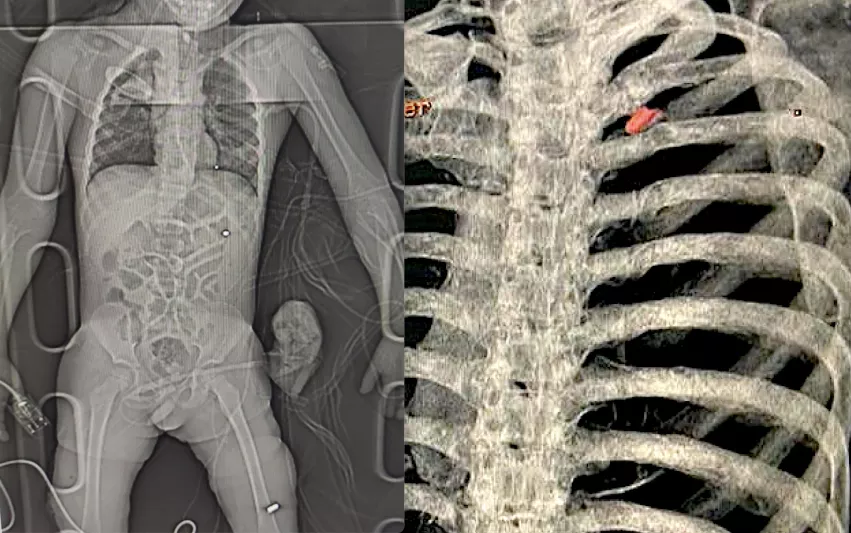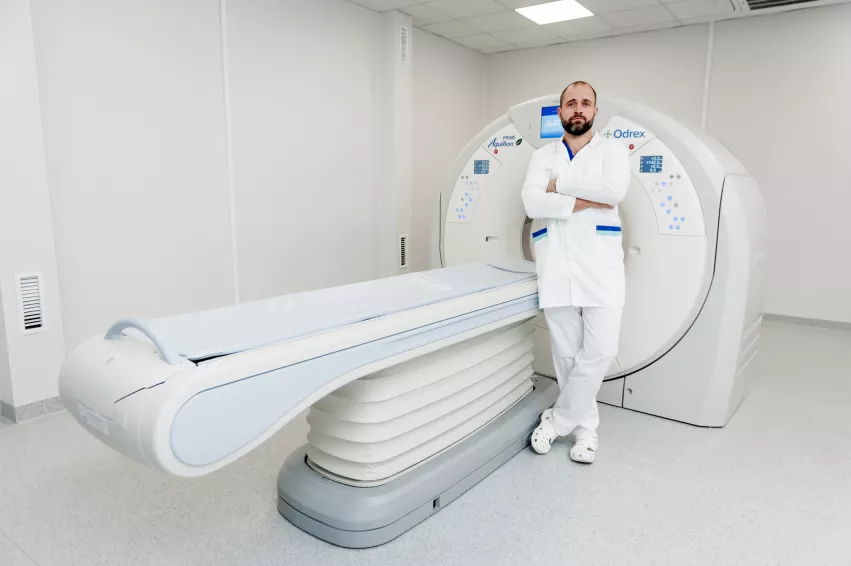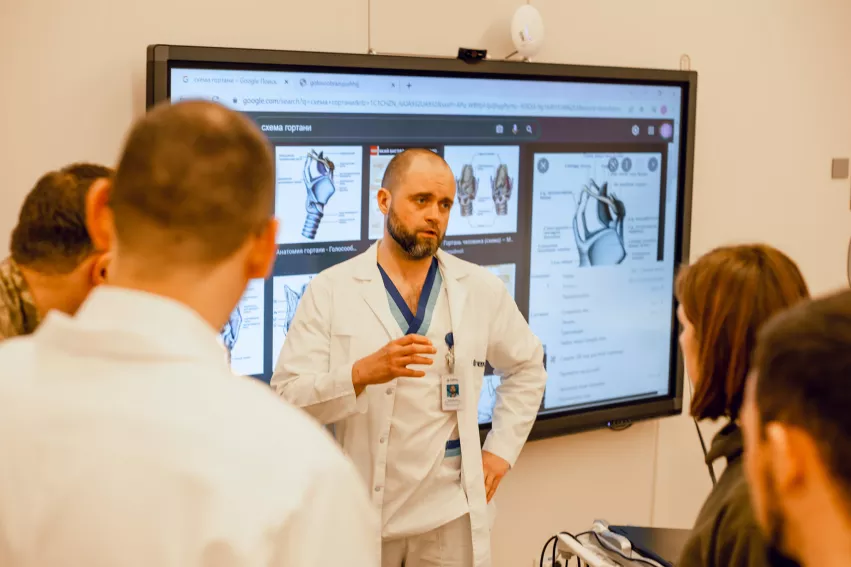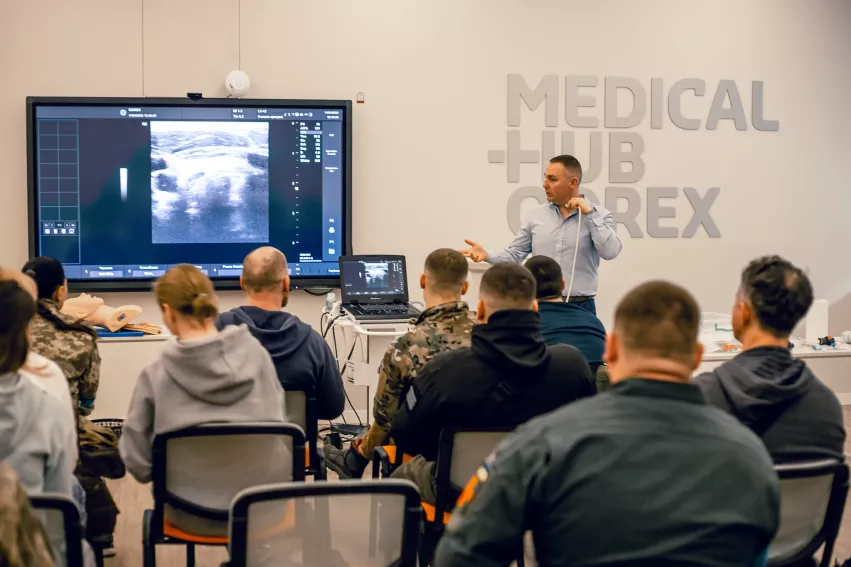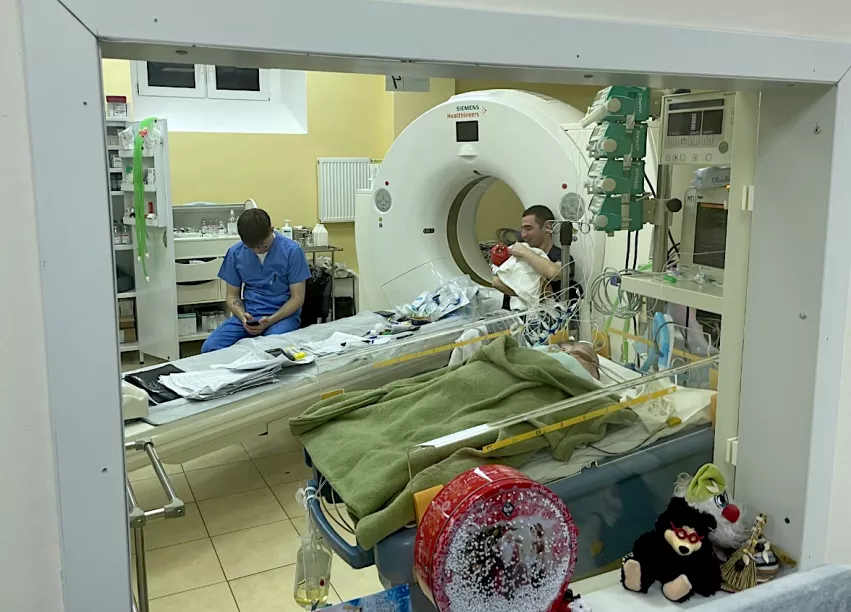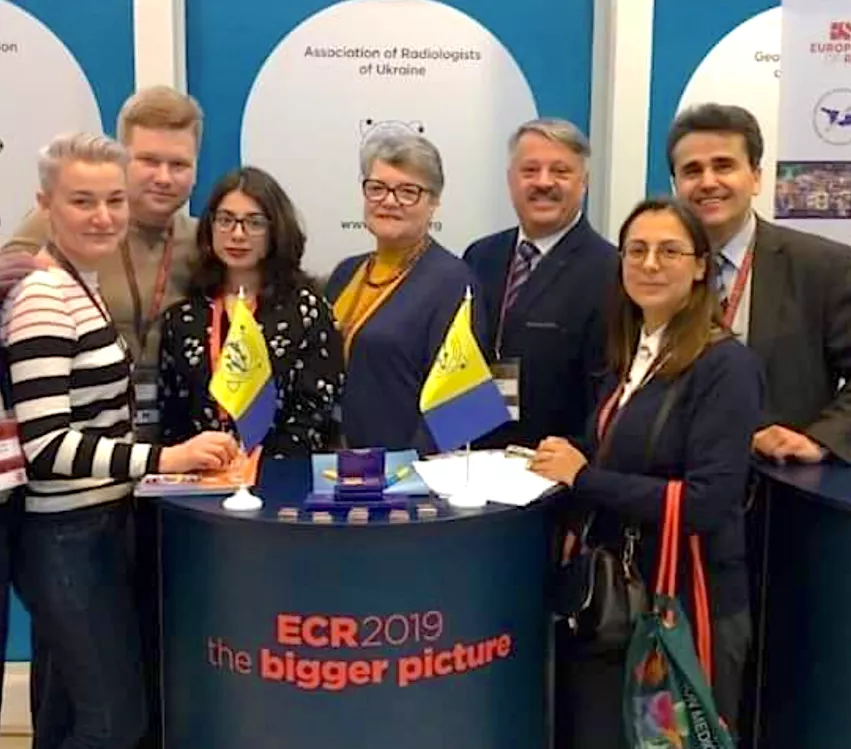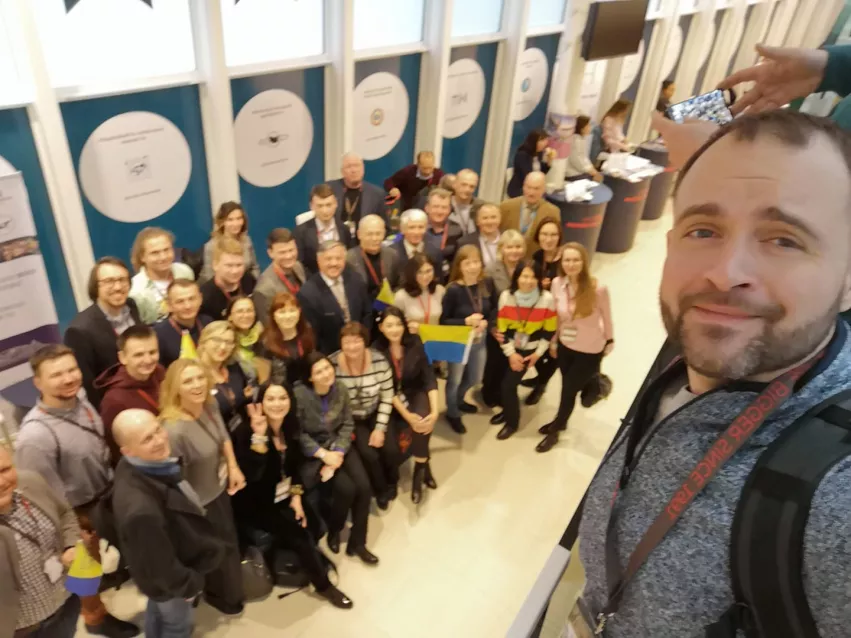Radiologists in Ukraine helping the war effort as Russia continues to attack
Ukrainian radiologists posted on social media they looked forward to attending the European Society of Radiology meeting in person again this year after two years of COVID. However, those plans quickly disappeared after Russia invaded their country on Feb. 24, 2022.
Many radiologists stepped up to do their part for the war effort by staying at their hospital posts to continue work with the normal workload of patients, in addition to helping the wounded as they started coming in. Many also began posting useful information from peer review journals on social media on how to assess war wounds in medical imaging, and how to treat patients with severe trauma, bullet wounds and bleeding.
"Starting on the first days we had wounded military coming into our hospital," said Alexander Berezovskiy, a Ukrainian radiologist and head of the X-ray diagnostic department at Odrex Medical House in Odesa, one of the largest private clinics in the south of Ukraine. However, he said most of the imaging his radiology department does is still the normal mix of patient studies.
Ukrainian radiologist Alexander Berezovskiy and head of the X-ray diagnostic department at Odrex Medical House in Odesa, Ukraine posing with his 64-slice Canon Aquilion Prime CT scanner. He said his hospital began treating wounded the first day of the war and now he helps run medical training for combat doctors and medics in the Ukrainian army. Image courtesy of Odrex
What has changed is how he spends his time to help train the Ukrainian military. "I have been teaching tactical medicine since 2015, so I spend approximately 50% of my time as head of the department of radiology, and 50% on tactical medicine training for the military," he explained.
He remembers as a child another war where his countrymen were being wounded and the need for good medical care from the start on the battlefield.
"My father was a military doctor, a colonel, who was involved in the evacuation of the wounded from Afghanistan during the Soviet-Afghan war. I already knew a lot from childhood," Berezovskiy said. "In 2014, I took instructor courses on the basis of the Medsanbat Project, after which I began to train military personnel to provide assistance according to the standards of NATO countries."
The Medsanbat Project was started after several months of military actions in Eastern Ukraine by Russian-back separatists in 2014. The numbers of wounded and killed made it clear that Ukraine’s military medicine lacked basic management and knowledge and most of those in the war zone had no experience in providing medical aid at battlefield. Medsanbat, launched in October 2014, was designed to fill this gap. The project provides training courses according to NATO standards to doctors and medical personal along with fully equipped medical backpacks.
Efforts by Medsanbat, and Berezovskiy, greatly intensified after the Russian invasion began. This has included webinars, sharing resources online as well as in-person training.
Berezovskiy has helped lead many sessions at Odrex to quickly bring military medics up to speed on how to care for their patients on the front lines.
Ukrainian radiologist Alexander Berezovskiy teaching battlefield triage and treatment of wounded during a training seminar for Ukrainian army medics and doctors at Odrex Hospital in Odesa, Ukraine. Image courtesy of Odrex
"Today we strengthen up combat doctors and aid units that are fighting for the life of the wounded on the battlefield," Berezovskiy wrote in a recent Facebook post about one of these training sessions at his hospital. "The main tasks of a combat physician arise from risks. This is a hemorrhaging and its consequences, hypovolemic shock. respiratory tract violations, hypothermia and pneumothorax. In the midst of intense combat operations and attacks on evacuation vehicles makes the role of military doctors critical and demands deeper training from them."
He eluded to ongoing issues with the Russian army concentrating artillery fire on many of the cease-fire agreement civilian evacuation corridors.
While Odesa is not on the front lines, it has been attacked regularly by Russian missile and air strikes. It is also the largest Ukrainian city of the Black Sea, so it is widely expected to be in the crosshairs of any Russian advances.
An armed member of a Ukrainian territorial defense unit checks out a new ambulance being donated Odrex Hospital in Odesa, Ukraine. The hospital donated the ambulance to enable the local unit the ability to transfer wounded to the hospital with current state-of-the art technology. Image courtesy of Odrex
Ukrainian Hospitals trying to maintain a business and usual approach during war
Despite treating some wounded and the initial fears the Russians might be in the city any day early in the invasion, two months on in the war, the hospital is actively trying to get patients to come in for the normal screenings, procedures and imaging. The Odrex website says its doors are still open for patients.
Ukrainian medics and doctors getting instruction on the use of a compact ultrasound system to assess wounded during a training session by doctors at Odrex Hospital in Odesa. Image courtesy of Odrex
"Team Odrex continues to work around the clock, clinic appointments open, all emergency services performing their job, prepared for operative and stationary," the hospital posted on its Facebook page on April 8, although the ad also states that they are prepared with a bomb shelter. "Of course, all the conditions for safety were formed: an equipped bomb shelter, a staff that helps get shelter and takes care of each patient. Therefore, the evacuation goes fast and without complications."
Even with occasional Russian air attacks and air-raid sirens heard regularly, the hospital says it is still offering the usual diagnostic imaging services for ultrasound, computed tomography (CT), MRI, X-ray, mammography, coronary angiography, and endoscopy.
A Siemens CT scanner room being used as an improvised intensive care unit (ICU) in the basement of the Scientific Practical Children's Cardiac Center in Kyiv, Ukraine. All patients, staff and clinical operations were moved into the basement of the hospital because of intensified Russian attacks on the city in early March.
Radiologist under constant bombardment in Kharkiv
Nikolai Bortny is an associate professor of radiology diagnostics at Kharkiv Medical Academy of Postgraduate Education. He has remained the the city of Kharkiv since the start of the war. He posts daily on Facebook to let people know the city has not yet fallen to the Russians and that the Ukrainian flag still flys above the city.
Kharkiv is only about 20 miles from the Russian border and it was a primary objective of the initial Russian invasion. However, in two months of constant fighting, the city has remained in Ukrainian hands.
"I do my job, trying to be useful to society, helping as much as I can," Bortny said in one of his recent posts.
Since April 4, the Kharkiv Medical Academy of Postgraduate Education went to full remote learning via video conferencing and email, so physician education can continue, despite the city being pounded by Russian artillery, missiles and bombs. The academy had stopped classes on Feb. 24, after the Russians invaded, but now they feel this is just the new normal and wanted to continue classes to keep moving forward.
"The evening of the 57th day of the heroic struggle of the Ukrainian people with the Russian occupants and the Ukrainian flag is still above Kharkiv," Bortny wrote on April 22. "Contrary to popular expectations that the city will fall soon, the Russians could not break through the lines of the Ukrainian army around Kharkiv and could not surround the city."
On April 7, he wrote about life in the city: "The enemy continues to try and block Kharkiv. The occupier has changed their tactics. The city is being fired from artillery, mortar and jet missile systems at night. At night when everyone is so defenseless. The enemy wants to demoralize us and continues to impose chaotic strikes on civilian infrastructure."
Soon after the attacks started, Bortny began posting links to peer-review articles on how to assess and treat trauma patients and combat wounded. He linked to literature in his social media posts from the Radiological Society of North America (RSNA) and European radiology society publications. He also summarized some main points from a lecture by doctors of the Royal London Hospital. He stated in that post most Ukrainian radiologists and many doctors are not trained in treating trauma patients and they need to learn fast. He offered his summery as a way for them to save time and lives.
Bortny is a member of the European Society of Radiology (ESR) and attended most recently the 2018 and 2019 meeting prior to COVID. On March 5, he shared a post from a friend on Facebook that outlined the Ukrainian radiologists' frustration and disappointment that the ESR did not take a strong stance against the Russian invasion early on like other several medical societies.
"I used to be proud, and now I am ashamed, that I was part of the society," he said. "Remain silent and pretend that you do not see anything."
ESR encourages radiologists to donate to help Ukraine
Later in March the ESC did published a statement from Prof. Michael Fuchsjäger, chairman of the ESR Board of Directors, in support of medical aid to Ukraine.
"We are writing to you with great sympathy for the plight of all Ukrainians," Fuchsjäger wrote. "Individually and collectively on behalf of the ESR, members of the Board of Directors deplore the loss of life and destruction resulting from the invasion of Ukraine initiated by the Russian leadership. As an apolitical academic, scientific and educational society, we feel it is important for us to do all within our power to support our Ukrainian colleagues and their patients during these catastrophic times."
ESR is supporting Doctors Without Borders (Médecins Sans Frontières - MSF), which is mobilizing an emergency response for Ukraine. The society also set up an account to collect donations on behalf of the radiological community with details to donate below:
IBAN: AT03 2011 1285 6166 3302
BIC: GIBAATWW
BANK NAME: DIE ERSTE BANK
ACCOUNT NAME: ESR
PLEASE KINDLY INDICATE “SUPPORT FOR UKRAINE” AS PURPOSE OF THIS TRANSFER.
Healthcare News Related to the Russian War in Ukraine:
Cardiac hospitals still treating patients as war in Ukraine continues
PHOTO GALLERY: Radiology images of Ukrainian trauma patients wounded in war
War in Ukraine has not stopped congenital heart surgeries in Kyiv
Radiologists in Ukraine helping the war effort as Russia continues to attack
U.S. government, American Hospital Association warn of potential Russian cyber attacks
Radiology leaders speak out in support of Ukraine
Cardiologists across the world share support for Ukraine as violent war continues
War in Ukraine: Doctor from pediatric cardiology clinic shot dead
